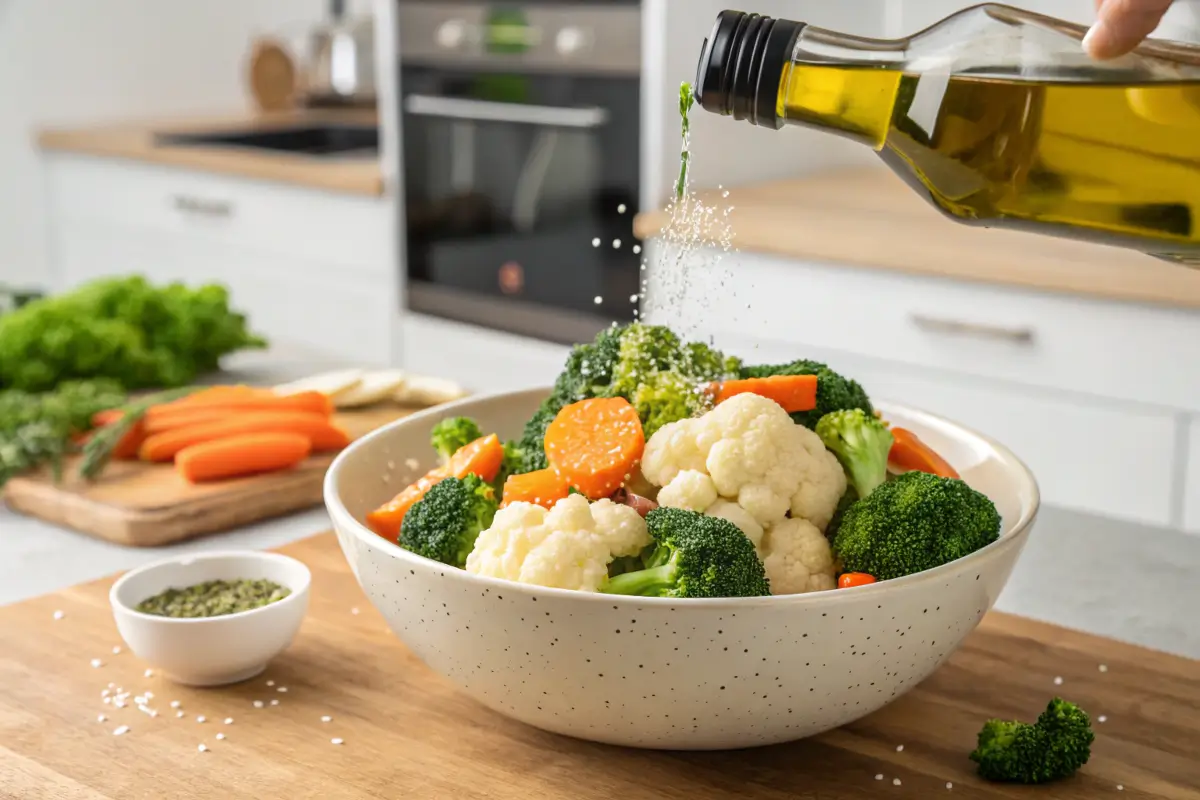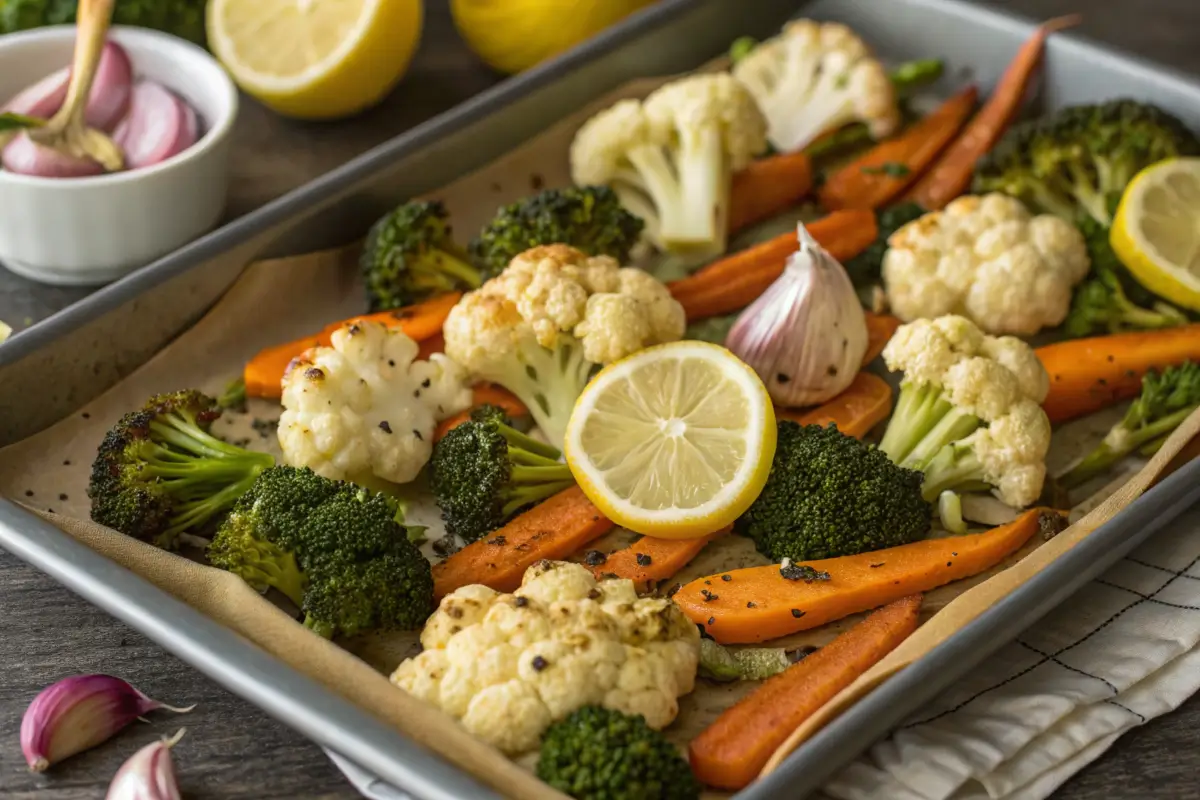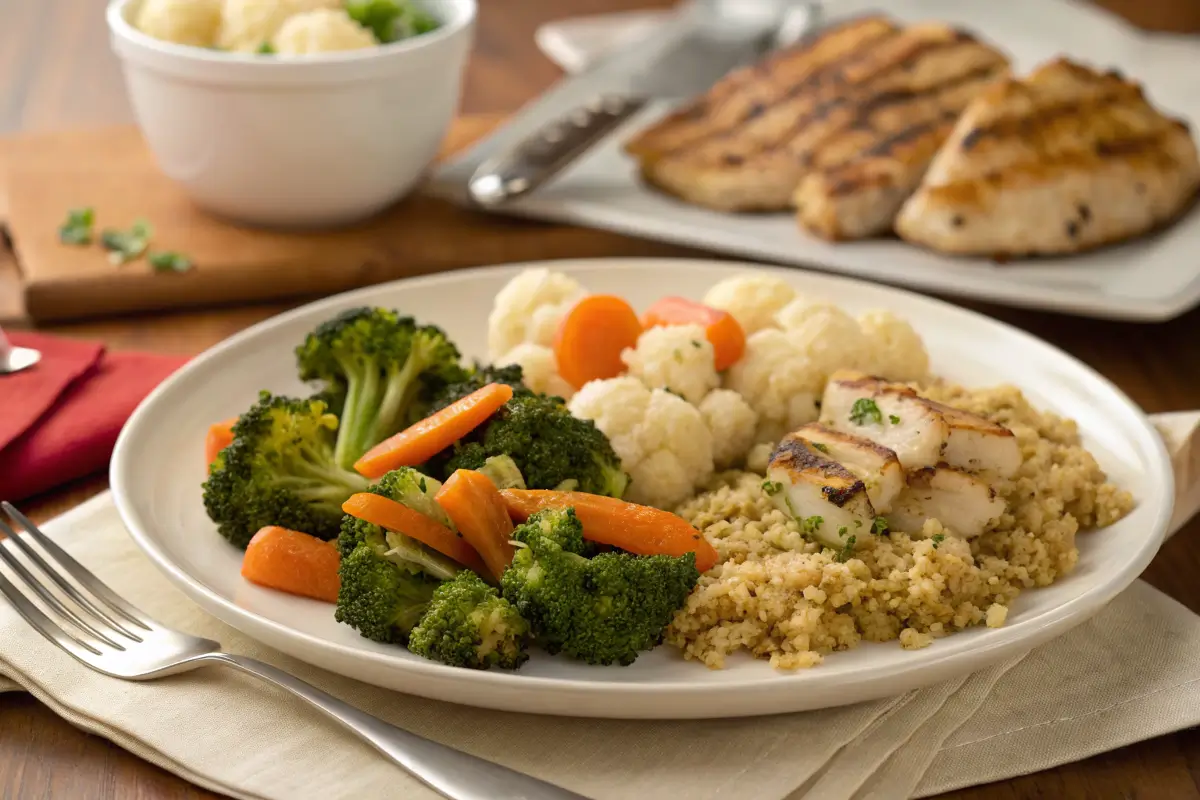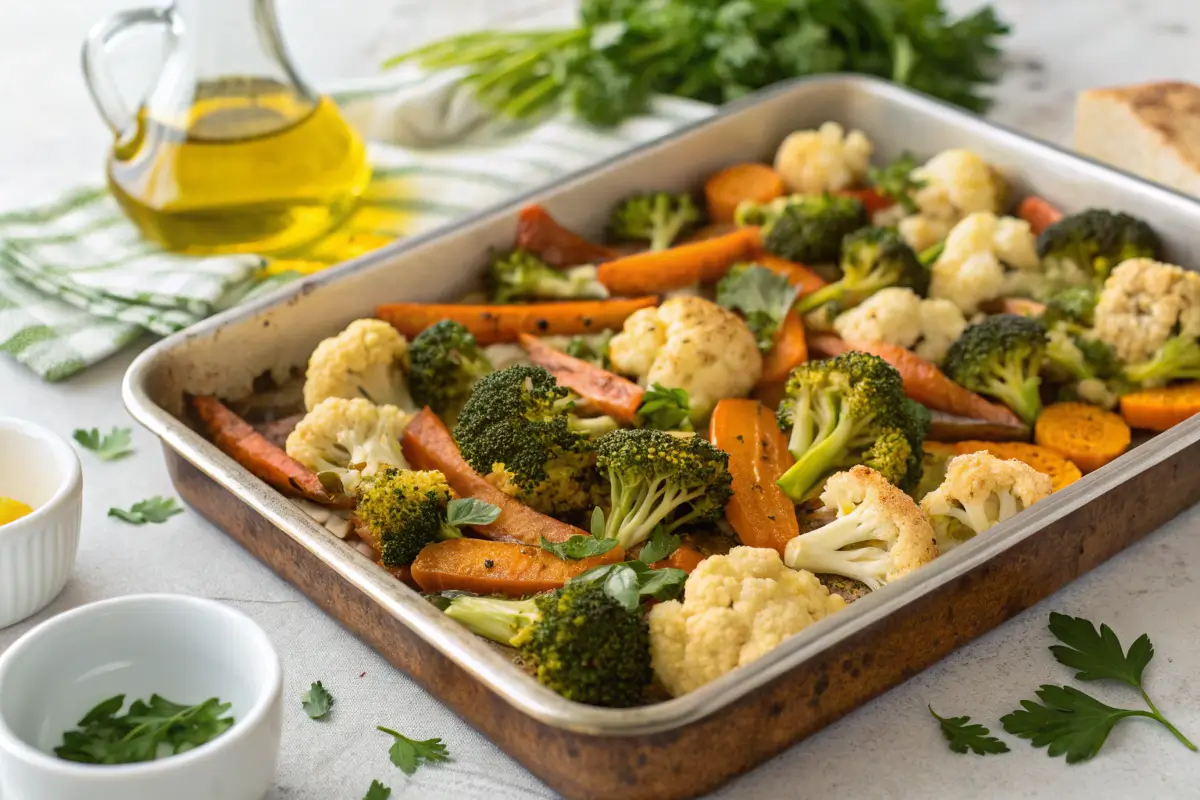Nothing beats the simplicity of making roasted broccoli, cauliflower, and carrots. It’s a quick and easy way to transform everyday produce into a flavor-packed dish. This article dives into everything you need to know about roasting these vegetables to perfection. From choosing the freshest ingredients to mastering the roasting process, you’ll find tips, tricks, and creative variations that’ll make this dish a staple in your kitchen.
We’ll also discuss the health benefits of roasted broccoli, cauliflower, and carrots, pairing ideas, and common mistakes to avoid. Whether you’re a seasoned cook or a beginner, this guide has got you covered. Let’s get roasting!
Introduction to Roasting Vegetables
Why Roasting Is Best for Broccoli, Cauliflower, and Carrots
Roasting vegetables isn’t just convenient—it’s a culinary game-changer. Unlike boiling or steaming, roasting brings out the natural sweetness and nuttiness in vegetables, thanks to a process called caramelization. The high heat of the oven works its magic by browning the surface, giving your broccoli, cauliflower, and carrots those irresistible crispy edges and tender interiors.
Plus, roasting is incredibly versatile. You can stick to a classic olive oil and salt combo or experiment with spices and marinades for endless variations. This method also helps vegetables retain their nutrients better than boiling, making it a healthy choice for busy weeknights or elegant dinners.
Nutritional Benefits of Broccoli, Cauliflower, and Carrots
These three vegetables aren’t just tasty—they pack a powerful nutritional punch. Broccoli and cauliflower are cruciferous veggies loaded with fiber, vitamins C and K, and antioxidants that support overall health. Carrots, on the other hand, are rich in beta-carotene, which converts to vitamin A, promoting healthy vision and skin.
When roasted, these vegetables don’t lose their nutrient density. Instead, the heat intensifies their natural flavors while keeping their health benefits intact. That makes roasted broccoli, cauliflower, and carrots a go-to dish for anyone looking to eat healthier without compromising taste.
The Appeal of Simple and Healthy Roasted Vegetables
Let’s face it—life gets busy. Recipes that are both simple and nutritious are a lifesaver. Roasted vegetables check all the boxes: they’re quick to prep, easy to cook, and endlessly customizable. You can whip up a batch for meal prep, serve them as a side, or even make them the star of your plate.
With minimal effort and maximum reward, it’s no wonder roasted broccoli, cauliflower, and carrots have earned their spot as a kitchen favorite. Stay tuned as we explore how to select, prep, and roast these veggies to perfection!
Choosing the Perfect Vegetables for Roasting
How to Select Fresh Broccoli, Cauliflower, and Carrots
When it comes to making roasted broccoli, cauliflower, and carrots, starting with the freshest ingredients is non-negotiable. For broccoli, look for tightly closed florets in a vibrant green hue. Avoid any that appear yellowish or have a strong smell, as these are signs of aging. Cauliflower should feel firm and heavy, with creamy white florets free from dark spots or blemishes. Meanwhile, carrots are best when they’re smooth, brightly colored, and firm to the touch.
Shopping local or visiting a farmer’s market can help ensure your produce is at its peak freshness. Not only do fresh vegetables roast better, but they also taste sweeter and retain more nutrients.
Seasonal Options for Roasted Broccoli, Cauliflower, and Carrots
Depending on the time of year, you might find slightly different varieties of these vegetables. Purple or orange cauliflower adds a colorful twist to your dish, while heirloom carrots in shades of purple and yellow can make your tray visually stunning.
If one of these isn’t available, feel free to mix in similar vegetables. Brussels sprouts, zucchini, or bell peppers make excellent additions or substitutions. Using what’s in season ensures maximum flavor and affordability while keeping your roasted broccoli, cauliflower, and carrots recipe exciting and adaptable.
For more vegetable ideas, check out this Broccoli and Cauliflower Salad Recipe from Dish It Recipes.
Preparing Broccoli, Cauliflower, and Carrots for Roasting

Washing and Drying Broccoli, Cauliflower, and Carrots
Before you begin, rinse all your vegetables thoroughly under cold water to remove dirt and pesticides. For broccoli and cauliflower, soak them briefly in salted water to help eliminate any hidden insects. Pat everything dry with a kitchen towel—this step is crucial, as excess moisture can hinder the roasting process.
Cutting Broccoli, Cauliflower, and Carrots for Even Roasting
Cutting your vegetables uniformly ensures they cook evenly. For broccoli and cauliflower, separate the florets into bite-sized pieces. Keep the stalks—they’re delicious when roasted! Just peel away the tough outer layer and slice them thinly.
As for carrots, you can cut them into rounds, sticks, or diagonal slices. Thicker pieces take longer to roast, so aim for ½-inch thickness for quicker cooking.
Blanching and Prepping Roasted Vegetables for Perfection
While optional, blanching or parboiling your broccoli, cauliflower, and carrots for 2–3 minutes can give you an edge. This step partially cooks the vegetables, helping them stay tender on the inside while getting crispy on the outside. After blanching, immediately transfer them to an ice bath to stop the cooking process, then dry them thoroughly before roasting.
By giving a little extra attention to prep, you’ll elevate your roasted veggie game from good to outstanding!
Seasoning Roasted Broccoli, Cauliflower, and Carrots

Simple Seasoning Ideas for Roasted Vegetables
When it comes to seasoning roasted broccoli, cauliflower, and carrots, simplicity often wins the day. A drizzle of olive oil, a pinch of kosher salt, and a grind of black pepper are all you need to bring out their natural flavors. Toss the vegetables in the mixture to ensure an even coating, and you’re ready to roast.
For a slight twist, consider adding a sprinkle of garlic powder or paprika. These subtle enhancements deepen the flavor without overpowering the vegetables.
Creative Flavors for Roasted Broccoli, Cauliflower, and Carrots
If you’re looking to mix things up, spice blends and marinades can add a world of flavor to your roasted veggies. Try a Mediterranean-inspired mix of oregano, thyme, and a touch of lemon zest. For a more robust profile, a curry powder blend pairs wonderfully with the sweetness of carrots.
Marinades are another excellent option. Combine olive oil, balsamic vinegar, honey, and a splash of soy sauce for a tangy-sweet glaze. Allow the vegetables to soak for 15–20 minutes before roasting. This technique creates caramelized edges and a rich depth of flavor.
Enhancing Roasted Vegetables with Fresh Herbs
Don’t underestimate the power of fresh herbs. Rosemary, thyme, or parsley sprinkled over the vegetables after roasting adds brightness and a pop of color. If you’re a fan of heat, finish with a dash of red chili flakes.
For other seasoning ideas, explore Southern Cornbread Recipe, which pairs wonderfully with roasted veggies.
Mastering the Roasting Process
Optimal Temperature for Roasting Broccoli, Cauliflower, and Carrots
To achieve perfectly roasted broccoli, cauliflower, and carrots, preheat your oven to 400°F (200°C). This temperature strikes the perfect balance between soft interiors and crispy edges. Roast the vegetables for 25–30 minutes, turning them halfway to ensure even cooking.
A higher temperature, such as 425°F (220°C), can work well if you prefer extra caramelization. Just keep an eye on the tray to avoid burning.
Tips for Caramelizing Roasted Broccoli, Cauliflower, and Carrots
Caramelization occurs when the natural sugars in vegetables break down under high heat. To maximize this process, ensure your vegetables are completely dry before roasting. Use a large baking sheet, spreading them out in a single layer. Overcrowding leads to steaming instead of roasting, which diminishes the final texture and flavor.
Coating the veggies in oil helps them crisp up, while salt draws out moisture, intensifying the taste. Tossing halfway through roasting guarantees that every side gets golden brown.
How to Prevent Overcooking or Burning Roasted Vegetables
Nobody likes mushy or burnt vegetables! Check the tray regularly during the last 5–10 minutes of roasting. If some pieces cook faster, remove them early and let the others finish.
You can also line your tray with parchment paper for easier cleanup and to prevent sticking. If you’re roasting different vegetables together, cut them into similar sizes or start with the ones that take longer to cook.
For another dish to complement your roasted vegetables, see the Balsamic Chicken Recipe for a perfect pairing idea.
Serving and Pairing Roasted Broccoli, Cauliflower, and Carrots

Perfect Side Dishes for Roasted Broccoli, Cauliflower, and Carrots
Roasted broccoli, cauliflower, and carrots shine as a side dish alongside many meals. Pair them with a hearty protein, like grilled chicken or baked salmon, for a balanced and satisfying plate. For vegetarians, they work beautifully with quinoa or lentils, creating a nutritious and colorful meal.
If you’re serving these vegetables as part of a holiday spread, they pair well with stuffing, mashed potatoes, or a light salad. Their caramelized flavors add a delightful contrast to creamy or rich dishes.
Turning Roasted Vegetables into a Main Dish
With a little creativity, roasted broccoli, cauliflower, and carrots can take center stage. Toss them with cooked pasta, olive oil, and parmesan for a quick dinner. Alternatively, add them to a grain bowl with brown rice, chickpeas, and a tahini drizzle for a healthy, plant-based meal.
Another option is to layer them in a casserole or bake them with a cheese sauce for a comforting dish. These roasted veggies are also fantastic on a pizza, topped with mozzarella and fresh basil.
For a simple yet impressive serving idea, arrange the roasted vegetables on a platter and sprinkle them with feta cheese and fresh herbs. Your guests will love the vibrant flavors and presentation!
Common Mistakes to Avoid When Roasting Vegetables
Avoid Overcrowding When Roasting Broccoli, Cauliflower, and Carrots
One of the biggest pitfalls when roasting vegetables is overcrowding the baking tray. When veggies are piled too close, they release steam, which prevents them from caramelizing properly. To avoid this, use a large tray or divide the vegetables between two sheets.
Using the Right Amount of Oil for Roasted Vegetables
Striking the right balance with oil is key. Too much oil makes the vegetables soggy, while too little can lead to dry, uneven cooking. A light drizzle is all you need—just enough to coat each piece evenly. Tossing the vegetables in a bowl before spreading them on the tray helps ensure thorough coating.
Importance of Preheating for Perfect Roasting
It might be tempting to skip preheating the oven to save time, but this step is crucial. Starting with a hot oven helps the broccoli, cauliflower, and carrots roast instead of steam. Always preheat your oven to at least 400°F (200°C) before placing the tray inside.
By avoiding these common mistakes, you’ll ensure your roasted vegetables turn out perfectly every time. With a little attention to detail, your roasted broccoli, cauliflower, and carrots will be the star of any meal!
FAQs About Roasting Broccoli, Cauliflower, and Carrots
Can You Roast Frozen Vegetables?
Yes, you can! However, frozen vegetables often contain extra moisture that can prevent them from achieving the same crispiness as fresh ones. To get the best results, roast them directly from frozen without thawing and spread them out on the baking sheet to avoid steaming. Adjust the cooking time slightly, as frozen veggies may take longer to caramelize.
What’s the Best Oil to Use for Roasting?
Olive oil is a classic choice for roasted broccoli, cauliflower, and carrots because it adds a rich flavor and promotes even browning. However, other options like avocado oil or melted coconut oil work well, especially if you prefer a neutral or slightly sweet taste.
How Do You Store Roasted Vegetables?
Store leftover roasted veggies in an airtight container in the fridge for up to 3–4 days. Reheat them in the oven or on the stovetop to restore some of their crispiness.
Can I Add Other Vegetables to This Mix?
Absolutely! Vegetables like sweet potatoes, zucchini, or bell peppers are great additions. Just make sure to cut them into similar sizes to ensure even cooking.
Health Benefits of Roasted Vegetables
Antioxidants in Broccoli and Cauliflower
Broccoli and cauliflower are part of the cruciferous vegetable family, known for their high antioxidant content. These compounds help protect your body from oxidative stress and support immune health. Additionally, broccoli contains sulforaphane, a compound that may have cancer-fighting properties, while cauliflower is rich in choline, which promotes brain function.
Beta-Carotene in Carrots for Eye Health
Carrots are famous for their beta-carotene, a precursor to vitamin A. This nutrient is essential for maintaining good vision, supporting your immune system, and keeping your skin healthy. When roasted, carrots develop a naturally sweeter flavor without losing their nutrient density.
The Role of Roasted Vegetables in a Balanced Diet
Incorporating roasted broccoli, cauliflower, and carrots into your meals is a delicious way to boost your daily intake of fiber, vitamins, and minerals. These vegetables are low in calories but high in nutrients, making them perfect for weight management and overall health.
Roasting is a cooking method that preserves nutrients better than boiling, ensuring you get the most out of every bite. Plus, the appealing taste of roasted vegetables can encourage even picky eaters to enjoy them, making them a win for families.
Popular Variations of Roasted Broccoli, Cauliflower, and Carrots
Cheesy Roasted Vegetables
For a decadent twist, try adding cheese to your roasted broccoli, cauliflower, and carrots. Once the vegetables are nearly done roasting, sprinkle shredded parmesan or mozzarella on top and return them to the oven for a few minutes. The cheese will melt and create a golden, crispy layer that’s hard to resist.
You can also mix the vegetables with a cheese sauce before roasting for an extra creamy result. This variation is perfect for kids or as a side dish for a holiday meal.
Roasted Vegetables with Garlic and Lemon
A bright and zesty option involves tossing your vegetables with minced garlic and lemon juice before roasting. The garlic adds a robust flavor, while the lemon juice enhances the natural sweetness of the carrots and the earthiness of the broccoli and cauliflower. For an extra zing, grate some lemon zest over the finished dish.
This variation pairs wonderfully with Mediterranean or seafood dishes, creating a refreshing balance of flavors.
Spicy Chili-Rubbed Roasted Vegetables
If you enjoy a bit of heat, spice things up with a chili-rubbed variation. Mix olive oil with chili powder, smoked paprika, and a pinch of cayenne pepper. Toss the broccoli, cauliflower, and carrots in the spicy oil before roasting.
The result is a smoky, slightly spicy dish that’s perfect for serving alongside grilled meats or as a topping for grain bowls. Add a dollop of yogurt or sour cream on the side to balance the heat.
These variations showcase the versatility of roasted vegetables, making it easy to adapt the dish to your taste or the occasion.
A Staple Recipe for Every Kitchen
Why This Dish Deserves a Spot in Your Meal Rotation
Roasted broccoli, cauliflower, and carrots are the epitome of simple, healthy, and flavorful cooking. Whether you’re making a quick weeknight meal or preparing a holiday feast, this dish is versatile enough to fit any occasion. With endless seasoning and serving possibilities, you’ll never run out of ways to enjoy these vegetables.
Encouragement to Experiment with Personal Touches
The beauty of this recipe lies in its flexibility. You can stick to a classic preparation or get creative with spices, herbs, and toppings. Try adding your favorite vegetables to the mix, experimenting with marinades, or pairing roasted veggies with different proteins and grains.
No matter how you make them, roasted broccoli, cauliflower, and carrots are sure to become a regular feature in your kitchen. So grab your baking tray, preheat your oven, and start roasting your way to delicious, nutrient-packed meals!

